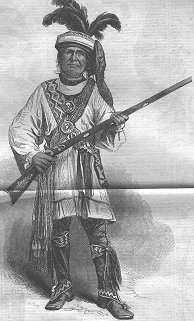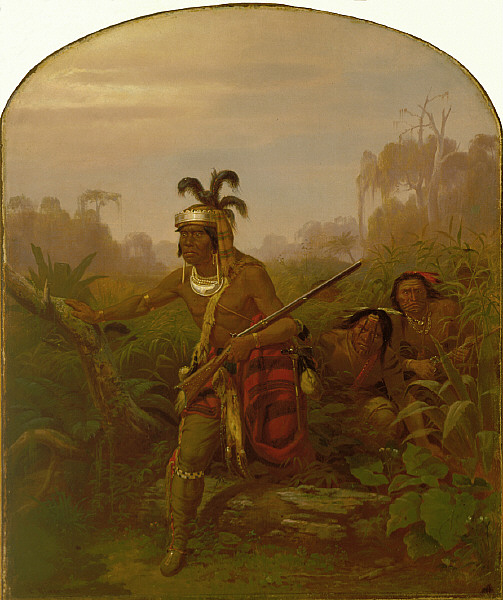Billy Bowlegs (Holata Micco, on:
[Wikipedia]
[Google]
[Amazon]
 Holata Micco (alternate spellings: Halpatter-Micco, Halbutta Micco, and Halpuda Mikko, meaning Alligator Chief; known by whites as Chief Billy Bowlegs or Billy Bolek) (c. 1810 – 1859) was an important leader of the
Holata Micco (alternate spellings: Halpatter-Micco, Halbutta Micco, and Halpuda Mikko, meaning Alligator Chief; known by whites as Chief Billy Bowlegs or Billy Bolek) (c. 1810 – 1859) was an important leader of the
 Bowlegs was born into a family of hereditary chiefs descended from Cowkeeper of the Oconee tribe of the Seminole in the village of Cuscowilla on the Alachua savannah (present-day
Bowlegs was born into a family of hereditary chiefs descended from Cowkeeper of the Oconee tribe of the Seminole in the village of Cuscowilla on the Alachua savannah (present-day
 In early 1858, Chief
In early 1858, Chief
Billy Bowlegs
, National Portrait Gallery
"Billy Bowlegs"
infoplease.com
"Billy Bowlegs"
Chronicles of Oklahoma, Vol. 33, 1955 {{DEFAULTSORT:Bowlegs, Billy 1810 births 1859 deaths People from Micanopy, Florida Seminole people Native American leaders Native American people of the Indian Wars Native Americans of the Seminole Wars People from Oklahoma
 Holata Micco (alternate spellings: Halpatter-Micco, Halbutta Micco, and Halpuda Mikko, meaning Alligator Chief; known by whites as Chief Billy Bowlegs or Billy Bolek) (c. 1810 – 1859) was an important leader of the
Holata Micco (alternate spellings: Halpatter-Micco, Halbutta Micco, and Halpuda Mikko, meaning Alligator Chief; known by whites as Chief Billy Bowlegs or Billy Bolek) (c. 1810 – 1859) was an important leader of the Seminole
The Seminole are a Native American people who developed in Florida in the 18th century. Today, they live in Oklahoma and Florida, and comprise three federally recognized tribes: the Seminole Nation of Oklahoma, the Seminole Tribe of Florida, an ...
s in Florida during the Second Seminole War
The Second Seminole War, also known as the Florida War, was a conflict from 1835 to 1842 in Florida between the United States and groups collectively known as Seminoles, consisting of Native Americans in the United States, Native Americans and ...
and was the remaining Seminole's most prominent chief during the Third Seminole War
The Seminole Wars (also known as the Florida Wars) were three related military conflicts in Florida between the United States and the Seminole, citizens of a Native American nation which formed in the region during the early 1700s. Hostilities ...
, when he led the Seminoles' last major resistance against the United States government. With the possibilities of military victory dwindling and facing starvation, he finally agreed to relocate with his people to Indian Territory
The Indian Territory and the Indian Territories are terms that generally described an evolving land area set aside by the Federal government of the United States, United States Government for the relocation of Native Americans in the United St ...
(present-day Oklahoma
Oklahoma (; Choctaw language, Choctaw: ; chr, ᎣᎧᎳᎰᎹ, ''Okalahoma'' ) is a U.S. state, state in the South Central United States, South Central region of the United States, bordered by Texas on the south and west, Kansas on the nor ...
) in 1858. He is buried in Hughes County, Oklahoma.
Early life and Seminole Wars
 Bowlegs was born into a family of hereditary chiefs descended from Cowkeeper of the Oconee tribe of the Seminole in the village of Cuscowilla on the Alachua savannah (present-day
Bowlegs was born into a family of hereditary chiefs descended from Cowkeeper of the Oconee tribe of the Seminole in the village of Cuscowilla on the Alachua savannah (present-day Payne's Prairie
Paynes Prairie Preserve State Park is a Florida State Park, encompassing a savanna in Alachua County, Florida lying between Micanopy and Gainesville. It is also a U.S. National Natural Landmark. It is crossed by both I-75 and U.S. 441 (which has ...
, near Micanopy, Florida
Micanopy ( ) is a town in Alachua County, Florida, Alachua County, Florida, United States, located south of Gainesville, Florida, Gainesville. The population as of the 2010 United States Census, 2010 census was 600. The oldest community in t ...
). His father's name was '' Secoffee'', while it is thought that the chief ''Micanopy
Micanopy (c. 1780 – December 1848 or January 1849), also known as Micco-Nuppe, Michenopah, Miccanopa, and Mico-an-opa, and Sint-chakkee ("pond frequenter", as he was known prior to being selected as chief), was the leading chief of the Sem ...
'' was his uncle. The surname "Bowlegs" may be an alternate spelling of ''Bolek
Bolek (died 1819), also spelled as Boleck or Bolechs, and known as Bowlegs by European Americans, was a Seminole principal chief, of the Alachua culture, Alachua chiefly line. He was the younger brother of King Payne, who succeeded their father ...
'', a preceding Seminole chief. (A story that he had bowlegs from riding horses is unsubstantiated.)
Although Bowlegs signed the Treaty of Payne's Landing
The Treaty of Payne's Landing (Treaty with the Seminole, 1832) was an agreement signed on 9 May 1832 between the government of the United States and several chiefs of the Seminole Indians in the Territory of Florida, before it acquired statehood.
...
of 1832, he refused to leave Florida. He wasn't well-noted at the beginning of the Second Seminole War
The Second Seminole War, also known as the Florida War, was a conflict from 1835 to 1842 in Florida between the United States and groups collectively known as Seminoles, consisting of Native Americans in the United States, Native Americans and ...
(roughly, 1835 to 1842). After the capture (under a flag of truce offered by Gen. Thomas Jesup
Thomas Sidney Jesup (December 16, 1788 – June 10, 1860) was a United States Army officer known as the "Father of the Modern Quartermaster Corps". His 52-year (1808–1860) military career was one of the longest in the history of the United St ...
) and subsequent death of Osceola
Osceola (1804 – January 30, 1838, Asi-yahola in Muscogee language, Creek), named Billy Powell at birth in Alabama, became an influential leader of the Seminole people in Florida. His mother was Muscogee, and his great-grandfather was a S ...
and the death of Micanopy, amidst the loss of other prominent Seminole chiefs, Bowlegs and his band of 200 warriors became some of the most prominent fighters surviving at the time hostilities ended on 14 August 1842. To impress and awe the Seminole chiefs, the US government brought Bowlegs to Washington, D.C. to underline the power of the United States.
Bowlegs and his band lived in relative peace until 1855. A group of army engineers and surveyors invaded his territory in southwestern Florida
Southwest Florida is the region along the southwest Gulf coast of the U.S. state of Florida. The area is known for its beaches, subtropical landscape, and winter resort economy.
Definitions of the region vary, though its boundaries are generally ...
, where they cut down banana trees and destroyed other property in the course of building forts. Some historians have viewed these actions as intentional provocation to make Bowlegs react, so the settlers would have a reason to force the Seminole out. If so, the provocation worked: Bowlegs led his warriors in sporadic attacks against settlers for the next few years, in what is known as the Third Seminole War. The Army was unable to subdue his guerrilla warfare
Guerrilla warfare is a form of irregular warfare in which small groups of combatants, such as paramilitary personnel, armed civilians, or Irregular military, irregulars, use military tactics including ambushes, sabotage, Raid (military), raids ...
.
Relocation
 In early 1858, Chief
In early 1858, Chief Wild Cat
Felidae () is the family of mammals in the order Carnivora colloquially referred to as cats, and constitutes a clade. A member of this family is also called a felid (). The term "cat" refers both to felids in general and specifically to the do ...
of the Western Seminole was brought back from Indian Territory
The Indian Territory and the Indian Territories are terms that generally described an evolving land area set aside by the Federal government of the United States, United States Government for the relocation of Native Americans in the United St ...
to convince Bowlegs to relocate voluntarily. The US government offered Bowlegs $10,000 and each of his chiefs $1000 if they did so. Warriors and non-warriors were offered less. They initially refused but later that year, the band of 123 agreed to relocation. Billy's Creek
Billy's Creek is a creek in Fort Myers, Florida. It is a tributary of the Caloosahatchee River and contains mangrove vegetation. The creek was named after the Seminole chief Billy Bowlegs who was forced to surrender there by United States
...
in Fort Myers, Florida
Fort Myers (or Ft. Myers) is a city in southwestern Florida and the county seat and commercial center of Lee County, Florida, United States. The Census Bureau's Population Estimates Program calculated that the city's population was 92,245 in 20 ...
is named after Bowlegs as this was the spot where he was forced to surrender in 1858.
In May, Bowlegs and his followers arrived in New Orleans
New Orleans ( , ,New Orleans
Merriam-Webster. ; french: La Nouvelle-Orléans , es, Nuev ...
, en route to Merriam-Webster. ; french: La Nouvelle-Orléans , es, Nuev ...
Arkansas
Arkansas ( ) is a landlocked state in the South Central United States. It is bordered by Missouri to the north, Tennessee and Mississippi to the east, Louisiana to the south, and Texas and Oklahoma to the west. Its name is from the Osage ...
and their new home in the Indian Territory. A journalist described the chief as having "two wives, one son, five daughters, and a hundred thousand dollars in hard cash." After reaching Indian Territory, Bowlegs became a leading chief there. He and his daughters became prominent land holders.
Other "Billy Bowlegs"
''Sonuk Mikko
Sonuk Mikko (unknown—ca. 1864), commonly known as Billy Bowlegs and also known as So-Nuk-Mek-Ko, was a Seminole who gained recognition as a captain in the American Civil War. Mikko adopted the name of Chief Billy Bowlegs from (Holato Micco), who ...
'', aka Billy Bowlegs, gained fame as a captain in the Union Army
During the American Civil War, the Union Army, also known as the Federal Army and the Northern Army, referring to the United States Army, was the land force that fought to preserve the Union (American Civil War), Union of the collective U.S. st ...
during the American Civil War. Some historical sources erred in conflating ''Holato Micco'' and the later ''Sonuk Mikko'', who both were called Billy Bowlegs., National Portrait Gallery
References
External links
"Billy Bowlegs"
infoplease.com
"Billy Bowlegs"
Chronicles of Oklahoma, Vol. 33, 1955 {{DEFAULTSORT:Bowlegs, Billy 1810 births 1859 deaths People from Micanopy, Florida Seminole people Native American leaders Native American people of the Indian Wars Native Americans of the Seminole Wars People from Oklahoma